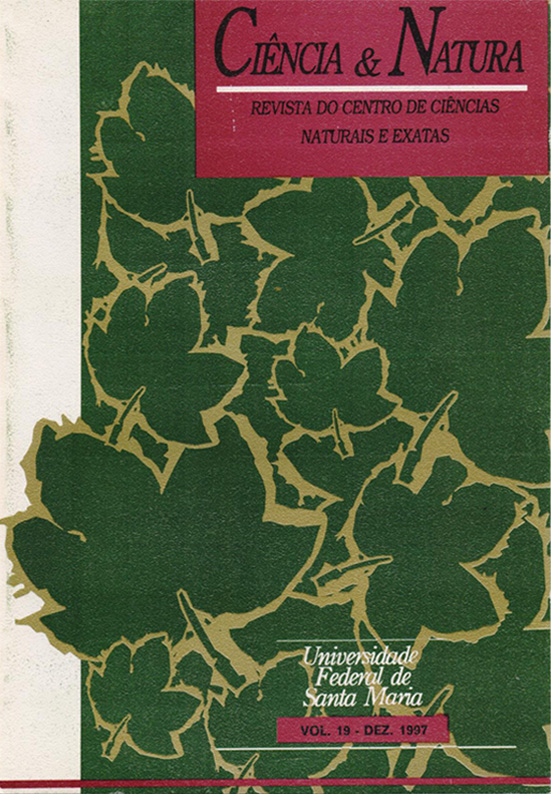Sensibilidade cromossômica à bleomicina em linfócitos de pacientes com síndrome de down, nas fases G0, G1 e S do ciclo celular
DOI:
https://doi.org/10.5902/2179460X26753Resumo
Linfócitos de pacientes com Síndrome de Down (SD) apresentam uma frequência aumentada de aberrações cromossômicas após exposição à radiação ionizantes nas fases G0 e G1 do ciclo celular. Entretanto, os linfócitos SD irradiados ou tratados com bleomicina (BLM) na fase G2 não apresentam um aumento significativo da frequência de aberrações. BLM é uma droga radiomimética que vem sendo utilizada em experimentos citogenéticos para verificar a capacidade individual de reparo de DNA. O objetivo deste estudo foi analisar a sensibilidade cromossômica de pacientes com SD à BLM, nas fases G0, G1 e S do ciclo celular. Foram feitas culturas de linfócitos, com e sem a droga, de 4 pacientes com SD e de 4 indivíduos normais, todos do sexo masculino e com idade inferior a 10 anos. Foram analisadas 100 metáfases mitóticas de cada tipo de cultura para cada indivíduo e foram registradas as aberrações cromossômicas e/ou cromatídicas. Os resultados obtidos mostram uma frequência mais alta de cromossomos dicêntricos, acêntricos, anéis e “double minutes” nas células SD nas fases G0 e G1, mas não na fase S, em relação a cédula de indivíduos normais. Possivelmente, a fase do ciclo celular na qual a célula é tratada é o principal fator envolvido na sensibilidade cromossômica de linfócitos de pacientes com SD.
Downloads
Referências
ATHANASIOU, K.; BARTSOCAS, C.S. The implications of S-phase exchanges for the mechanisms of radiosensitivity in trisomy 21. Am. J. Med. Genet., v.12, p.141-146, 1982.
BARTHOLOMEI-SANTOS, M.L. & LUCCA, E.J. Chromosome sensitivity to bleomycin in G2 lymphocytes from Down Syndrome patients. Braz. J. Genetics, v.20, p.79-85, 1997.
DEKABAN, A.S.; THRON, R.; STEUSING, J.K. Chromosomal aberrations in irradiated blood and blood cultures of normal subjects and of selected patients with chromosomal abnormality. Radiation Res., v.27, p.50-63,1966.
FONG, C. & BRODEUR, G. M. Down's syndrome and leukaemia: leukemogenesis. Cancer Cytogenet., v.28, p55-76, 1987.
HSU, T.C.; JOHNSTON, DA; CHERRY, L.M.; RAMKISSOON, D.; SCHANTZ, S.P.; JESSUP, J.M.; WINN, R.J.; SHIRLEY, L.; FURLONG, C. Sensitivity to genotoxic effects of bleomycin in humans: possible relationship to environmental carcinogenesis. Int. J. Cancer, v.43, p.403-409, 1989.
LEONARD, J.C.; MERZ, T. The influence of cell cycle kinetics on the radiosensitivity of Down syndrome lymphocytes. Mutat. Res., v.109, p.111-121,1983.
MORIMOTO, K.; KANEKO, T.; IIJIMA, K.; KOIZUMI, A. Proliferative kinetics and chromosome damage in trisomy 21 lymphocyte cultures exposed to -y-rays and bleomycin. Cancer Res., v.44; p.1499-1504, 1984.
PRESTON, R.J. X-ray-induced chromosome aberrations in Down lymphocytes: an explanation of their increased sensitivity. Environ. Mutagen., v.3, p.85-89, 1981.
SHAFIK, H.M.; AU, W.W.; LEGATOR, M.S. Chromosomal radiosensitivity of Down syndrome lymphocytes at different stages of the cell cycle. Hum. Genet., v.78, p.71-75, 1988.
Downloads
Publicado
Como Citar
Edição
Seção
Licença
Para acessar a DECLARAÇÃO DE ORIGINALIDADE E EXCLUSIVIDADE E CESSÃO DE DIREITOS AUTORAIS clique aqui.
Diretrizes Éticas para Publicação de Revistas
A revista Ciência e Natura está empenhada em garantir a ética na publicação e na qualidade dos artigos.
A conformidade com padrões de comportamento ético é, portanto, esperada de todas as partes envolvidas: Autores, Editores e Revisores.
Em particular,
Autores: Os Autores devem apresentar uma discussão objetiva sobre a importância do trabalho de pesquisa, bem como detalhes e referências suficientes para permitir que outros reproduzam as experiências. Declarações fraudulentas ou intencionalmente incorretas constituem comportamento antiético e são inaceitáveis. Artigos de Revisão também devem ser objetivos, abrangentes e relatos precisos do estado da arte. Os Autores devem assegurar que seu trabalho é uma obra totalmente original, e se o trabalho e / ou palavras de outros têm sido utilizadas, isso tem sido devidamente reconhecido. O plágio em todas as suas formas constitui um comportamento publicitário não ético e é inaceitável. Submeter o mesmo manuscrito a mais de um jornal simultaneamente constitui um comportamento publicitário não ético e é inaceitável. Os Autores não devem submeter artigos que descrevam essencialmente a mesma pesquisa a mais de uma revista. O Autor correspondente deve garantir que haja um consenso total de todos os Co-autores na aprovação da versão final do artigo e sua submissão para publicação.
Editores: Os Editores devem avaliar manuscritos exclusivamente com base no seu mérito acadêmico. Um Editor não deve usar informações não publicadas na própria pesquisa do Editor sem o consentimento expresso por escrito do Autor. Os Editores devem tomar medidas de resposta razoável quando tiverem sido apresentadas queixas éticas relativas a um manuscrito submetido ou publicado.
Revisores: Todos os manuscritos recebidos para revisão devem ser tratados como documentos confidenciais. As informações ou ideias privilegiadas obtidas através da análise por pares devem ser mantidas confidenciais e não utilizadas para vantagens pessoais. As revisões devem ser conduzidas objetivamente e as observações devem ser formuladas claramente com argumentos de apoio, de modo que os Autores possam usá-los para melhorar o artigo. Qualquer Revisor selecionado que se sinta desqualificado para rever a pesquisa relatada em um manuscrito ou sabe que sua rápida revisão será impossível deve notificar o Editor e desculpar-se do processo de revisão. Os Revisores não devem considerar manuscritos nos quais tenham conflitos de interesse resultantes de relacionamentos ou conexões competitivas, colaborativas ou outras conexões com qualquer dos autores, empresas ou instituições conectadas aos documentos.






